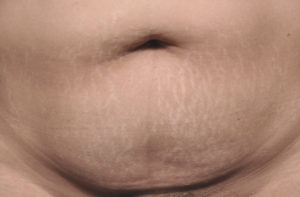
But what makes stretch marks such a difficult aesthetic problem to improve? To understand the why, it is important to look at the histology of stretch marks which are anatomically described as Striae Distensae. Technically there are two distinct forms of striae distensae, striae rubrae and striae albae. By histologic assessment, normal skin has haphazardly arranged small collagen fibers and thin elastin fibers in the papillary dermis, surrounded by ground substance; coarse elastic fibers and thick bundles of collagen parallel to the direction on the skin in the reticular dermis.
In contrast, striae rubae (red stretch marks) are tense, red and erythematous and they histologically show fine elastic fibers in the dermis with thicker tortuous fibers in the periphery. There is a reduction and reorganization of elastin fibers and structural changes in collagen are seen. Striae albae (white or pale stretch marks) appear pale, depressed and wrinkled. Their histology demonstrates epidermal atrophy and loss of the rete ridges and densely packed thin collagen bundles are arranged horizontally, parallel to the surface of the skin in a similar way to in a scar.
These histologic findings show that stretch marks are distinctly different from normal skin. Their collagen infrastructure is drastically changed to thinner less oriented collagen layers with fewer elastic fibers. This is well known by their depressed and indented external surface lines. Trying to change this weakened and thinner collagen by any type of topical cream or treatment, while theoretically appealing and makes for robust retail product sales, is fundamentally flawed and not possible. You simply can’t thicken the damaged collagen structure of the skin. No clinical study has ever been published that supports any sustained effectiveness for topical therapies for stretch marks.
Can more invasive treatments, like laser resurfacing, laser collagen stimulation or an internal approach like Cellulaze, be effective? At the least they can have a more profound effect on the skin’s collagen infrastructure. Other than reducing redness from striae rubae, external or internal laser efforts not been shown to be effective either.
Stretch mark therapy today remains largely ineffective. The changes to the skin’s structure remains permanently changed and irreversible…at least by today’s technology.
Dr. Barry Eppley
Indianapolis, Indiana


